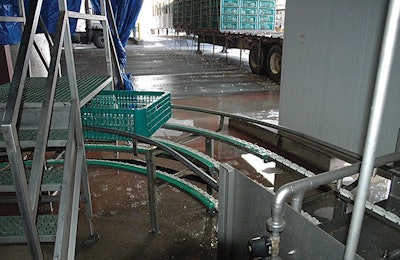
Campylobacter and Salmonella are leading causes of human bacterial foodborne disease and are epidemiologically linked to poultry and poultry products. What is the role of the transport coops for spreading this contamination in broiler chickens?
Reasons to consider washing
Transport cages have been demonstrated as a significant source of bacterial contamination from one flock to the next. Back in 2002, research showed that efforts to control Salmonella (and now Campylobacter) need to concentrate on crate cleaning and disinfection. Reasons for transport crate contamination are:
- Inadequate cleaning
- Disinfectant concentration and temperature of disinfectant
- Contaminated recycled flume water used to clean crates
In a typical commercial operation, broilers are caught on the farm and placed into cages for transport. Filled cages are taken to the processing plant, emptied and immediately put back in service. Soiled transport coops may or may not be cleaned and sanitized between uses. Some poultry companies in the U.S. are washing cages, but – due to ongoing Campylobacter issues and concerns – cage washing is more common in the U.K.
Obstacles to overcome
In the U.S., many companies not currently washing their transport cages may be reconsidering. The main reasons these companies aren’t using cage washing systems are the cost and logistics. Major modifications to the animal receiving and transport area would be required. Companies would need to change the style of cages used for catching and transport and install washing and sanitation equipment.
Further concerns include the cost of the chemicals to wash and sanitize cages as well as containment and treatment of cage wash runoff water. Drying washed cages can be an effective antimicrobial strategy. Some effective drying may be achieved on the truck during transport to the next farm.
The potential costs of not washing
Each company must consider if transport cage sanitation is important enough to justify the total cost of the operation. One part of that calculation will be the potential cost of Campylobacter and/or Salmonella positive cages increasing changes of failed regulatory tests of fully processed broiler carcasses.
In the foreseeable future, many poultry companies may find it in their best interests to wash and sanitize transport cages between uses.
References available upon request.
Read more:
Forced hot air reduces Campylobacter in broiler transport, www.WATTAgNet.com/articles/29973
















